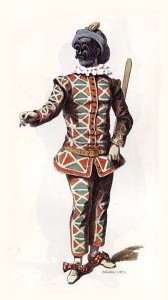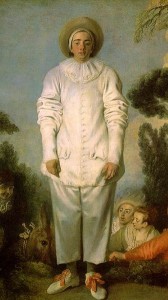Comedy Genres: Physical Comedy
Posted on 05 March 2013
Humour that is expressed through physical action is probably the earliest comedy we all experience. From the likes of Sesame Street to In The Night Garden we learn about pratfalls, double takes, mugging, and physical sight gags. The largely overlapping fields of mime, clowning, and slapstick comedy have built up whole traditions from which to draw when comically engaging with an audience.
Silent Era Comedy and Before
Greek comedy certainly made use of a form of proto-clowning. Our Western experience of both clowning and mime finds its roots in Commedia dell’arte, and in particular the characters of Arlecchino (Harlequin) and later Pierrot. This form of theatre and its clowns became popular across Europe. Shakespeare’s rude mechanicals were drawn from the clowns that were in regular employ by Elizabethan theatres in the late sixteenth century. In fact Pierrot’s appearance in English pantomimes eventually evolved into the Christmas pantos we know today.
 |
 |
Vaudeville, music halls, and circus certainly made use of all aspects of clowning. Film brought clowning back into prominence.
Many people like pointing to Charlie Chaplin as the pinnacle of silent era comedy, but not all his clowning has withstood the test of time. His tramp character is often given to extreme violence and meanspirited behaviour. Nevertheless, he originated and popularised many familiar shticks. In By The Sea (1915) he slips on a banana peel in a well executed pratfall.
Harold Lloyd was nearly as famous as Charlie Chaplin in his time. He had the physical skills to pull off some amazing comic stunts, such as his famous scene where he is hanging from a clock on the top of a skyscraper. All of the stars in that era did their own stunts and without benefit of safety equipment.
Buster Keaton would have to be the long term winner of silent physical comedy. His short One Week has gags that modern film makers are still using in their comedies. Jackie Chan is renowned for heavily borrowing from Keaton.
Talkies
Talking pictures were the death knell for the careers of many silent actors. However, this was not as true of the comedians. Stan Laurel and Oliver Hardy started out in silent pictures, but were able to smoothly transition to talkies even with Laurel’s accent.
This has been credited to their continued use of silent gags and incidentally blending in sound elements. I would dispute that assessment. Their dialogue is sharp, well-delivered, and funny. It just isn’t as theatrical as other talkies of the era. In fact their scripting has an astonishingly modern approach, with overlapping dialogue and interesting interactions with ambient sound. These all support their well developed sense of physical comedy.
The Marx Brothers continued this tradition of blending clown elements with sharp dialogue. Groucho supplied much of the satiric commentary. Harpo would provide most of the outright physical comedy. Chico was funny in his own right, and also served as a bridging character between Groucho and Harpo. Their success in particular paved the way for the continued popularity of clowning and mime on the big screen.
Later in the Hollywood film era we have people like Danny Kaye, Jerry Lewis, and Dick Van Dyke still playing with silent era style gags.
Danny Kaye famously learned to use mime when he was touring the orient, in order to make himself understood by the audiences. His skills as a physical comedian are displayed at their finest in his film The Court Jester.
Jerry Lewis’s career began when he worked with his parents performing in the Catskills. At fifteen he had an act where he mimed to the popular songs of the day. His physical performances from then on remained big and goofy. Most astonishingly in 1960 he produced and performed in what was essentially a silent film The Bellboy. It’s my favourite of his movies.
One of Dick Van Dyke’s earliest gigs was as part of comedy duo Eric and Van—The Merry Mutes. They performed a mime act similar to that of the young Jerry Lewis, where they lip-synced to popular songs. Van Dyke eventually started getting small comedy spots on television variety shows, which led to his own series. His pratfall at the opening of The Dick Van Dyke Show is fondly remembered. However, his physical comedy in films such as Mary Poppins and Chitty Chitty Bang Bang continues to be influential.
TV
Many early black and white TV comedies made use of slapstick: The Abbott and Costello Show, I Love Lucy, and Gilligan’s Island, to name a few.
A popular television format for many years was the variety show. Certain types of mime and clowning are very formalised, but through television, people’s interest in these arts has been maintained.
Mime Marcel Marceau for instance gained much of his international popularity through his regular appearances on shows such as Mike Douglas and Dinah Shore. He even worked with former circus clown and television variety show host Red Skelton (as did Jerrry Lewis).
Carol Burnett, my hero and a fine physical comedian in her own right, brought iconic American clown Emmett Kelly to perform with her on The Carol Burnett Show. With the pairing you could see how much her cleaning lady character, and modern comedy in general, owes to the clowning tradition.
The Muppet Show liked mixing both nostalgia and current culture, while dipping heavily into the slapstick oeuvre. This was demonstrated by their eclectic selection of guest stars. Shields and Yarnell are a good example. Their mime was crisp, focused, and innovative, bringing mime into the present day. The Mummenschanz and their form of mask clowning were brought to national public attention through The Muppets.
International
Physical comedy is of course beloved the world around. Many slapstick and mime artists have gained international notoriety without having to go through the Hollywood system.
For instance French actor/director Jacques Tati coupled a gentle charm with his silent shenanigans, making him a film favourite. If you haven’t seen Mon Oncle, I strongly suggest you acquire a copy. It is a comic masterpiece.
In a similar vein Italian actor/director Maurizio Nichetti brings laugh out loud whimsy to his films while playing the silent innocent. His material is hard to track down, but if you can get hold of either a copy of Volere Volare or The Icicle Thief, I’m sure you will be pleased with the results. Nichetti loves the juxtaposition of a simple character thrown into absurdly complex situations.
Jackie Chan studied Chinese circus arts as a child. These held him in good stead when he began to star and then write and direct his films. His blend of martial arts action with slapstick comedy was hugely successful in Hong Kong. His reputation spread to other countries. Eventually, he was making movies in both Hong Kong and Hollywood. Some of you may remember Shanghai Noon.
I don’t think any article about physical comedy would be complete without mentioning Rowan Atkinson and particularly his character of Mr Bean. Unlike Harold Lloyd or Jackie Chan, his comedy is not about athleticism, but expressive awkwardness. Atkinson’s television show Laughing Matters: Visual Comedy is highly insightful and includes some investigation of physical comedy.
Australia
Australia has a proud history of clowning. Our most successful early comedian would have to be Roy Rene, also known as the clownish Mo McCackie. I am not certain how much physical comedy he employed. He was born 1891 and came into prominence as Mo in 1916. Most of his comedy was live or on radio. His one film was a box office failure. Nevertheless, he is fondly remembered and a statue of him as Mo stands in Hindley Street, Adelaide.
The Aunty Jack Show in the 1970s made clowning hip, mixing the culture of the day with the usual cross-dressing and outrageous big hair that one might find at a circus. Their sketches bear some resemblance to Monty Python, but Aunty Jack was running concurrently, and they both may have been inspired by the work of Spike Milligan and Richard Lester.
More recently our finest physical comedians would have to be The Umbilical Brothers and Frank Woodley. The Umbilical Brothers combine clowning, mime, and vocal sound effects. Their award-winning children’s program The Upside Down Show was developed by Sesame Workshop and shown on US TV. Frank Woodley is largely remembered for his partnership with Colin Lane in Lano & Woodley. He is something of the “Stan Laurel” to Lane’s “Oliver Hardy”. His live solo show Possessed involved slapstick stunts such as sliding down a staircase. When you think how many nights in a row Woodley was doing that, he must have been covered in bruises at the end of the show’s run.
One thing that concerns me on the behalf of Australian comedians is when international comedians come to the Melbourne Comedy Festival, watch our shows then use shticks, carefully crafted by our finest, in their own shows elsewhere. This would not be such a problem if we still lived in a world without global media. How else would people in far separated countries ever get a chance to laugh at these gems? Nowadays running off with a shtick can harm the reputations of those who originated them. I have seen this done to both The Umbilical Brothers and Lano & Woodley.
Physical comedy is an ageless delight. The laughter it evokes is genuine and heartfelt. Doing it properly (and safely) requires training or at least long practise. As silly and basic as mime, clowning, and slapstick are, they deserve our respect.
Peace and kindness,
Katherine
Responses are closed for this post.
